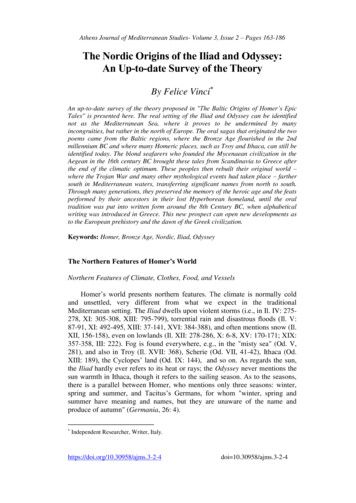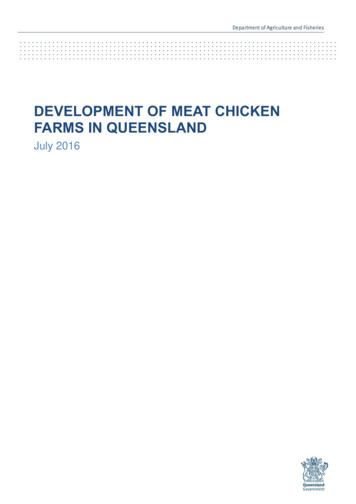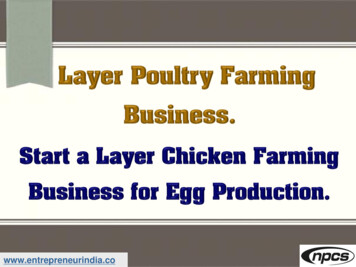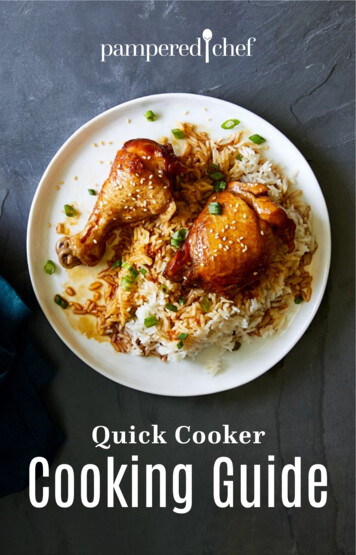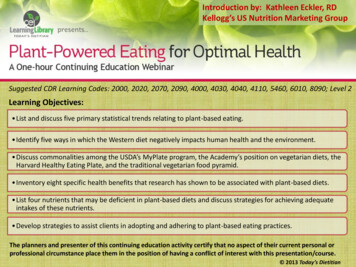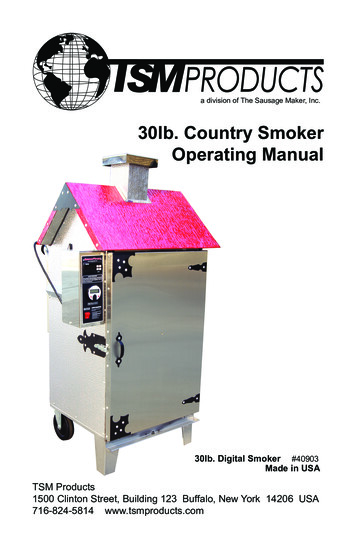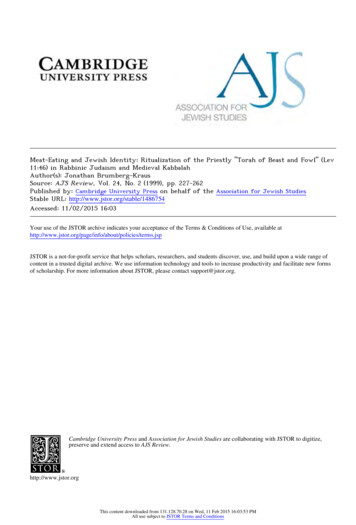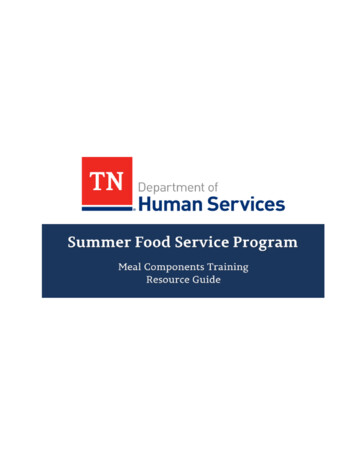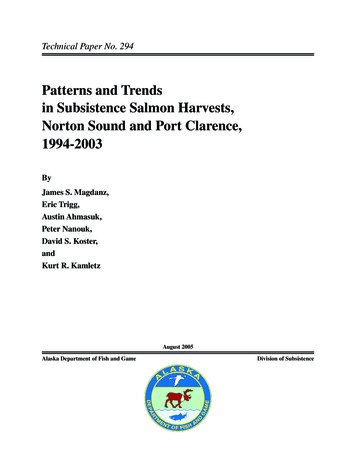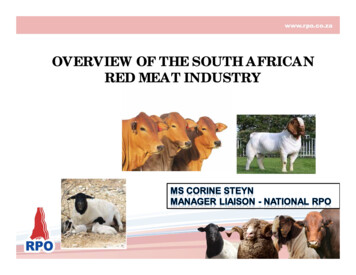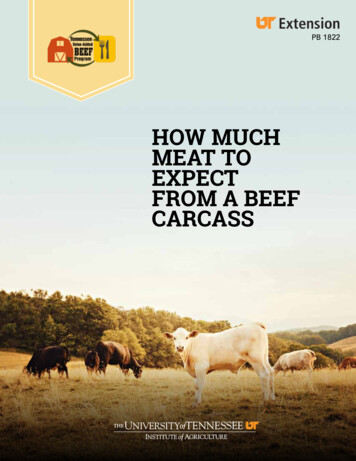
Transcription
PB 1822HOW MUCHMEAT TOEXPECTFROM A BEEFCARCASS
Rob Holland, DirectorCenter for Profitable AgricultureDwight Loveday, Associate ProfessorDepartment of Food Science and TechnologyKevin FergusonUT Extension Area Specialist-Farm ManagementUniversity of Tennessee Institute of Agriculture
CONTENTS2.Introduction3.Dressing Percentage5.Chilled Carcass and Primal Cuts6.Sub-primal Meat Cuts6.Factors Affecting Yield of Retail Cuts7.Average Amount of Meat from EachSub-primal Cut9.SummaryUniversity of Tennessee Institute of Agriculture
IntroductionConsumers who buy a live animal from a local cattle producer forcustom processing are often surprised. Some are surprised at thequantity of meat and amount of freezer space they need. Othersmay be surprised that they did not get the entire live weight of theanimal in meat cuts. The amount of meat actually available froma beef animal is a frequent source of misunderstanding betweenconsumers, processors and cattle producers. This documentprovides information to assist in the understanding of how muchmeat to expect from a beef carcass. The information providedhere should be helpful to consumers who purchase a live animalfor freezer beef and to cattle producers involved in direct andretail meat marketing.2 University of Tennessee Institute of Agriculture
How Much Meat to Expect from a Beef CarcassDressing PercentageOne of the terms used in the cattle and meat cutting industry that often leadsto misunderstanding is dressing percentage. The dressing percentage is theportion of the live animal weight that results in the hot carcass. The dressingpercentage is calculated as:(hot carcass weight the live animal weight) 100The hot carcass weight (HCW) is the weight of the unchilled carcass in poundsafter the head, hide and internal organs have been removed. For most fed cattle,the HCW will be approximately 60 to 64 percent of the live animal slaughterweight. However, the HCW can vary greatly from one animal to another.For a 1,200-pound animal with a hot carcass weight of 750 pounds, thedressing percentage is 62.50 and calculated as follows:(750 hot carcass weight 1,200-pound live weight) 100 62.50 percentIt is not uncommon for the buyer of a live animal to say, “The dressingpercentage of my 1,200-pound steer was 62.5 percent but I only got 450pounds of meat — where is the rest of the meat?” The calculation of dressingpercentage is based on the hot carcass weight. The hot carcass weightincludes bone, excess fat and moisture loss that will not be packed andwrapped for home consumption. The hot carcass weight is not the amountof meat that the consumer will put in his or her freezer.Many factors can affect the dressing percentage.Anything that adds to the weight of the live animalbut does not appear on the carcass will lower thedressing percentage. Items that might add to thelive animal weight but not be included in the hotcarcass weight include: Hide Pregnancy Horns Mud and or manure Gut fillon the hideUniversity of Tennessee Institute of Agriculture3
All beef animals are not the same. Therefore, the dressing percentagewill change from one animal type to another. Some of the primaryfactors that influence the dressing percentage include the type ofanimal in terms of breed, live weight and how it was finished. Table 1shows the relative average dressing percentage for various types of beefanimals and conditions.Table 1. Average Dressing Percentages forVarious Types of CattleType/Condition of Beef Animal Relative Dressing PercentageTraditional Feedlot Beef Type62-64 percentRestricted Feed Prior to Weighing HigherCattle Weighed Without Gut Fill HigherOver-finished (fat) Beef TypeHigherUnder-finished (thin) Beef TypeLowerGrass finished LowerDairy TypeLowerPregnant HeiferLowerMature Cow LowerCattle Weighed With Gut Fill LowerEven though the factors used to calculate dressing percentage are standard(live animal weight and hot carcass weight), there are variations in how andwhen each of these weights are recorded. The live animal weight can varydepending on whether the live animal weight was recorded on the farm priorto transportation to the harvesting facility or immediately prior to harvestingat the harvest facility. Also, the hot carcass weight is the weight of the carcassbefore it is chilled. A beef carcass is 70 to 75 percent water. As it is chilled,water evaporation will cause the carcass weight to decrease. If the carcassweight used to calculate dressingpercentage is the chilled carcassweight, then the dressing percentagewill be lower than if the hot carcassweight had been used. It is notuncommon for a chilled carcass toweigh 2 to 5 percent less than thehot carcass. That is, a 750-poundhot carcass may lose 20 poundsor more in evaporation in thefirst 24 hours of chilling.4
How Much Meat to Expect from a Beef CarcassChilled Carcass and Primal CutsThe term dressing percentage is often usedin the meat industry and around harvestingfacilities. However, it is important to understandthat dressing percentage alone does not givean accurate estimate of how much meat will beavailable for a consumer’s freezer.After a carcass is cooled, it will be furtherprocessed into cuts of meat. The whole animalcarcass will be cut into halves, and then eachhalf will be separated into the hind and frontquarters. Each quarter is then separated into“primal” (or wholesale) cuts. This process isreferred to as “breaking down the carcass.” Beefprimal cuts in the front-quarter are the rib chuck,shank, brisket and plate; the hind quarter iscomposed of the flank, round and loin (short loinand sirloin). Figure 1 shows the typical weightsand percent of a chilled carcass for the variousprimal cuts of beef from a 1,200-pound live steerand a 750-pound hot carcass. The round, loin, riband chuck are the major beef primals and arereferred to as the “thick” cuts. The other primalsare referred to as the “thin” cuts.Figure 1. Typical Weights and Percent of a ChilledCarcass for the Various Primal Cuts of Beef from a1,200-pound Live Steer (750-pound hot carcass).Chuck201.0 lbs.26.8%LoinRib72.0 lbs.9.6%Brisket28.5 lbs.3.8%Round129.0 lbs.17.2%Short Plate62.25 lbs.8.3%168.0 lbs.22.4%Flank39.0 lbs.5.2%Shank23.25 lbs.3.1%MiscellaneousAll percentages are basedoff of total hot carcass27 lbs.3.6%(kidney, hanging tinder,fat and cutting losses)University of Tennessee Institute of Agriculture5
Sub-primal Meat CutsPrimal cuts will be furtherprocessed into sub-primals or intoretail cuts. The basic concept ofcutting beef retail cuts is to separatetender muscles from less tendermuscles, to separate thick musclesfrom thin muscles and to separatefatter from leaner portions.For example, according to thepublication titled “Beef Cuts:Primal & Sub-primal Weights andYields” produced by the NationalCattlemen’s Beef Association,the round typically makes up22 percent of the hot carcass— for a 750-pound carcass, theround would be approximately165 pounds. The round may befurther cut into 132 pounds ofmeat that will be packed andwrapped for consumption. Thatis, approximately 20 percent ofthe round is lost to fat and bone.The round can be fabricated intothe following four sub-primal cutsplus ground beef trimmings andstew meat: Top round Bottom round Eye of round Tip (Knuckle) Ground beef Stew meatFactors Affecting Yieldof Retail CutsThere are several factors that caninfluence the amount of meat thatwill be wrapped for the freezer.Some of the more common factorsand an explanation of each areprovided below:Carcass Fat — External carcassfatness has the greatest impacton the percent retail productfrom a carcass. As more fat istrimmed away from the retailcuts, less weight will be in thepackaged meat and consequentlya lower percentage of retail cutsfrom the carcass.Carcass muscularity — Superiorcarcass muscling can increasethe percentage of retail product.Dairy-type animals with lowerlean-to-bone ratios typically yieldlower than beef-type animals.Considering carcass fat andcarcass muscularity, carcass fathas greater impact on decreasingyield than carcass muscularity’simpact on increasing yield.Cutting style — Cutting style orthe cutting directions given tothe processor can affect carcassyields. The major effects ofcutting style can be explainedby the amount of bone-in versusboneless cuts, trimming of retailcuts and the amount of fat in theground beef. Because bone canweigh quite a lot, the more bone6 University of Tennessee Institute of Agriculturethat is left in retail cuts results inmore packaged meat weight andthus an increase in percentageyield. Conversely, if the chuckand round roasts are boneless, therib is cut entirely into bonelesssteaks, the loin is cut intotenderloin and strip steaks, andthe short ribs put into ground beef,then considerable bone weighthas been removed and the percentyield of retail cuts will be muchlower. Going to 1/8-inch trim or ano-trim (no external fat) on theretail cut or producing an extralean ground beef will also lowerthe percentage of take-homeproduct. As with external fat, themore fat that is removed, the lessweight is put in the packages.Aging — The two major advantagesof aging meat are the improvementin tenderness and theenhancement of a “beefy” flavor.A typical aging period of seven to10 days will optimize tenderness.Long-term aging also can have anegative effect on carcass yield.With longer aging times, there ismore weight loss from the carcassdue to moisture evaporation. Alsowith longer aging time, there canbe dehydration to the carcasssurface. These dry, leathery areasshould be trimmed away. Again,this is another weight loss thatwill result in lowering the carcassyield. Losses from extended agingtimes can be a bigger problem withcarcasses with very little fat cover.
How Much Meat to Expect from a Beef CarcassTable 2. provides an estimate of the amount of meatto expect from an average beef carcass. While theactual amount of each cut will vary based on animaltype and cutting techniques, the information in Table2 gives an estimate of the amount of meat to expect.Table 2. Average Amount of Meat froma 1,200-Pound Live Beef AnimalGroundBeefTrim(Inches)Lean(%)Fat(%)Approx. amt.of freezermeat (lb.)Boneless steaks and roasts1/89010425Bone-in steaks and roasts1/48020500Mixture of bone-in andboneless steaks and roasts1/88020490Boneless steaks and roastsfrom very fat animal1/89010348Boneless steaks and roastsfrom Holstein (dairy animal)*1/89010396Cuts*A Holstein steer was used in the example to show how a light-muscledanimal will affect the amount of take-home product.Source: South Dakota State University. Note: Estimations may vary by 25pounds or more.Average Amount of Meat from EachSub-primal CutLess than half of a live animal’s weight at harvestis actually available as various meat cuts for takehome beef. For example, a 1,200-pound steer witha 62.5 percent dressing percentage yields a hotcarcass of 750 pounds. After further processing andde-boning, approximately 527 pounds of meat willbe wrapped for consumption. Figure 2 shows theamount of meat that can result from each primaland sub-primal beef cut.University of Tennessee Institute of Agriculture7
Figure 2. Amount of Meat that Can Result fromEach Primal and Sub-primal Beef Cut.RibChuckRIB 72.0 lbs.Loin(9.6 percent of total hot carcass)CHUCK 201.0 lbs.UsableMeat(26.8 percent of total hot carcass)UsableMeatFat andBoneStanding ribroast29.5Blade pot-roast72.3Rib steak15.1Stew or ground beef39.2Short ribs5.8LOIN 129.0 lbs.Fat andBone(17.2 percent of total hot carcass)UsableMeatPorterhouse steak22.8T-bone steak11.6Arm pot-roast27.2Braising beef3.3Club steak6.3Cross rib pot-roast13.0Ground beef4.3Sirloin steak50.5Boston cut12.1Fat and bone14.0Ground beef3.514.0 lbs.Fat and boneFat and bone37.2TOTAL 163.8 lbsTOTAL58.0 lbsTOTAL37.2 lbs.UsableMeatSHORT PLATE 62.25 lbs.Brisket(8.3 percent of total hot carcass)UsableMeatBRISKET 28.5 lbs.(3.8 percent of total hot carcass)TOTALFat andBonePlate, stew, short ribsFat and boneFat andBone49.812.45TOTAL 49.8 lbs. 12.45 lbs.11.4Fat and boneFlank17.1 lbs.Top round(inside)25.6Bottom round(outside)24.7Tip16.0Stew10.1Rump5.9Kabobs orcube2.6Ground beef17.3Fat andBoneFat and bone17.111.4 lbs34.3 lbs.(22.4 percent of total hot carcass)Short PlateBoneless34.394.7 lbsROUND 168.0 lbs.All percentagesare based ontotal hot carcassweightUsableMeatFat andBoneTOTAL 102.2 lbs65.865.8 lbs.FLANK 39.0 lbs.(5.2 percent of total hot carcass)UsableMeatSHANK 23.25 lbs.(3.1 percent of total hot carcass)Flank3.9Ground beef15.4FatTOTAL8 University of Tennessee Institute of AgricultureFat andBone(3.6 percent of total hot carcass)19.719.3 lbsMiscellaneous 27 lbs.19.7 lbs.(kidney, hanging tinder,fat and cutting losses)
How Much Meat to Expect from a Beef CarcassSummaryThe amount of meat that is cut and wrapped forconsumption will be much less than the live animalweight. A 1200-pound beef animal will yield a hotcarcass weight of approximately 750 pounds. Oncecooled, the carcass weight will be approximately730 pounds. When de-boned and trimmed, there willbe approximately 500 pounds of trimmed and deboned meat for wrapping and freezing.Table 3. shows the average weight and percentagesas the live animal weight is processed intotrimmed and boneless cuts.Table 3. Average weight and Percentages ofMeat Available in Trimmed and Boneless CutsWeight% of liveweight% of hotcarcass% of chilledcarcassLive animal1,200100%Hot Carcass75062%100%Chilled Carcass73060.8%97%100%Trimmed andBoneless Cuts50041.7%66%68%It is important to understand that these numberswill vary based on many factors. Not all harvestedanimals weigh 1,200 pounds — some may beharvested at 900 pounds and some at 1,300pounds. Some animals may be dairy-type andothers may be beef-type. Some may be grassfinished and some may be grain-finished.Additional information that can be helpful inunderstanding how much meat to expect froma beef carcass is available in UT Extensionpublication PB 1820, “Improving Communicationswith Your Beef Processor.”University of Tennessee Institute of Agriculture9
This publication has beenprepared for the TennesseeValue-Added Beef Programwhich is supported in partby funding from the sale ofagricultural specialty licenseplates (the “Ag Tag”). Fundsreceived from Ag Tag salesare returned to the agriculturalcommunity in the form of grantsfor youth programs, marketingdevelopment projects and otheragricultural activities. State fundsfor this project were matchedwith Federal funds underthe Federal-State MarketingImprovement Program of theUSDA Agricultural MarketingService, U.S. Department ofAgriculture. The TennesseeValue-Added Beef Program isalso supported in part by UTExtension and the Center forProfitable Agriculture.andFederal-State Market Improvement Programag.tennessee.edu14-0238 06/14 5MPrograms in agriculture and natural resources, 4-H youth development, family andconsumer sciences, and resource development. University of Tennessee Institute ofAgriculture, U.S. Department of Agriculture and county governments cooperating.UT Extension provides equal opportunities in programs and employment.12 University of Tennessee Institute of Agriculture
retail meat marketing. University of Tennessee Institute of Agriculture 3 How Much Meat to Expect from a Beef Carcass Dressing Percentage One of the terms used in the cattle and meat cutting industry that often leads to misunderstanding is dressing percentage. The dressing percentage is the
